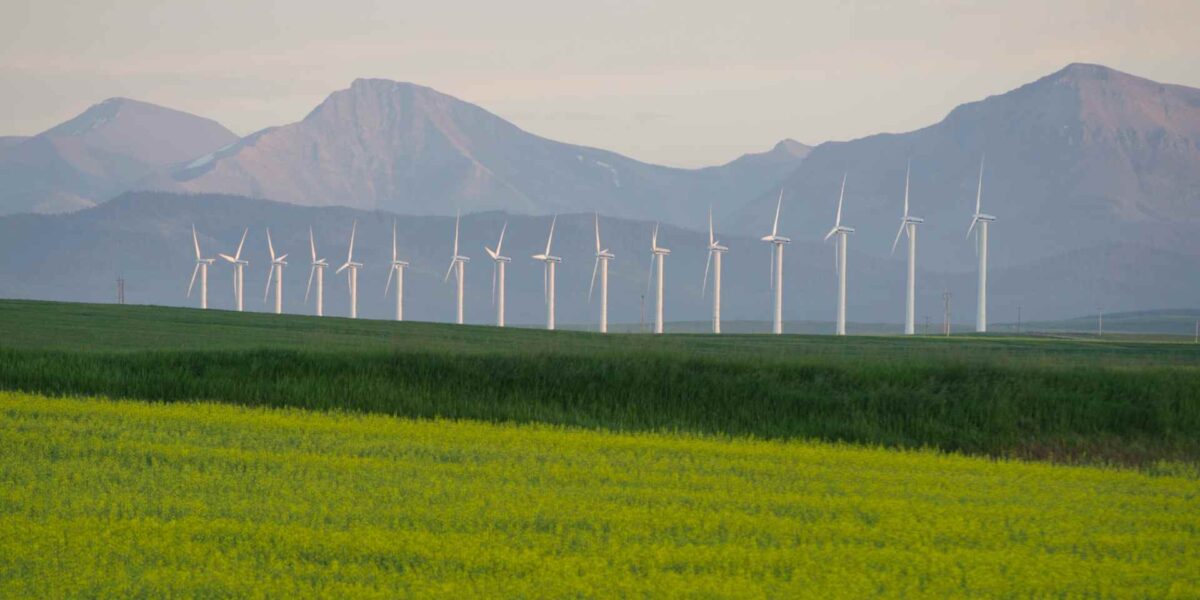Nearly a year has passed since Alberta announced the no-go buffer zones for renewable energy development. By the end of 2024, the government released a map outlining a 70,0000km² buffer zone surrounding the Rockies and another 82,000km² visual impact assessment zone.
The 2024 Alberta Wilderness Association (AWA) report highlighted land availability as a limitation of these buffer zones. Ruiping Luo, conservation specialist at AWA and author of the report, found the restriction could exclude 36 to 39 per cent of Alberta’s land from any renewable energy development. Moreover, these buffer zones target prairie regions with high concentrations of sun and wind resources.
“The government proposed these buffer zones where wind energy is not allowed and solar has to go through its own visual impact assessment … They explained that these buffer zones are about preserving pristine viewscapes,” said Luo in an interview with rabble.ca.
Ecologically, the notion of protecting pristine viewscapes holds little weight, added Luo—especially since these areas are already impacted by other industry such as oil and gas.
“Where they’ve chosen to put these buffer zones seems to us very arbitrary. There isn’t any science or any strong research on why these buffer zones should be in certain areas other than they have decided these are pristine viewscapes. That seems very targeted towards the renewable energy industry,” said Luo.
According to the Alberta government, the buffer zone policy is meant to protect agricultural land. But Stephen Legault, Senior Manager Alberta Energy Transition for Environmental Defence Canada, is skeptical.
“This notion that this is being done to protect agricultural land is laughable. Agricultural land has been most heavily impacted by oil and gas development over the past 50 years as conventional oil and gas plays have been explored and exploited, particularly in the foothills, the prairie and the parkland,” said Legault.
If anything, renewable energy would have less of an impact on agriculture land-use. For instance, only 0.08 per cent of all agricultural land would be needed to achieve a net zero solar future. Conservation groups like the AWA and Environmental Defence continue to question the fairness of the policy on renewable energy developments.
READ MORE: AB energy minister lifts ban on coal exploration on Rockies Eastern Slopes
“You don’t see this being imposed on any of the oil and gas. You don’t see it being imposed on coal mining, which we would argue has a lot more devastating consequences for the landscape and for the viewscape,” said Luo.
Policy slows Alberta’s energy transition, ‘employment bubble’ about to burst
Government regulations have made it difficult for clean energy projects to gain traction—and so questions arise about how Alberta can remain competitive in the evolving energy market.
“It’s not just about oil and gas versus renewable energy. It’s about coming to grips with the reality of our province’s economic dependence on oil and gas when there are clear trend lines globally, that the market for our product is shrinking and will someday possibly even disappear,” said Legault.
There are also concerns that the no-go buffer zones will drive away investments—which is exactly what happened in 2023 with the moratorium on renewable projects. An analysis from Pembina Institute found that 53 renewable energy projects withdrew their applications in the last year.
Legault also warned of an impending challenge in the labour force. According to Legault, where investments go, the jobs tend to follow.
“There’s a demographic bubble that is going to burst, and we’re going to have a real employment challenge here … If we were serious about keeping that employment bubble from bursting, then we’d be working hard right now to figure out what the future of energy is in this province, not what the past is,” said Legault
No-go buffer zones are a step in the right direction—if applied across all energy sectors
Legault noted that conservation activists have called for no-go buffer zones industrial development for years—so when the buffer zones were applied solely to renewable energy developments, he said it came as a surprise.
“Certainly, Environmental Defense supports the idea that for any kind of energy development, there has to be rules and standards, and there has to be consistency. There are places where the landscape is too sensitive, because that’s the truth. There are places where you shouldn’t be putting wind farms or solar farms,” said Legault.
“But that said, we would like to see that be consistently applied across the energy sectors.”
Luo reiterated this point, adding that if the Alberta government were truly aiming to protect environmental land, then they should strive for science-based policy.
“If this is an area that’s worth protecting, that’s important for Alberta, then it shouldn’t be just protected from renewable energy. It should be protected from oil and gas, from infrastructure from mining and surface minerals—all these different industrial developments that could destroy the area,” said Luo.
Meanwhile, the Alberta government announced doubling its crude oil production to the United States in early January. To support this effort, a working group between Enbridge and Alberta Petroleum Marketing Commission (APMC) will be assembled—one of their priorities include working “with government to cut red tape and streamline regulations and permitting approvals.”
On top of increasing crude oil exports to the US, the moratorium on coal mining was lifted in the Rocky Mountains and Eastern Slopes—coincidentally enough, areas that reside within the designated buffer zones.
“I mean, you don’t have to be a conspiracy theorist to see that there’s a clear bias happening right now in Alberta against renewable energy,” said Legault.



